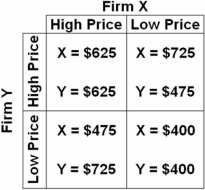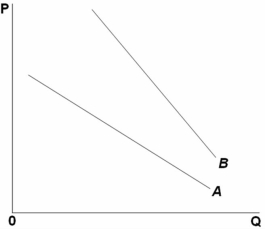A) ignore a price cut but follow a price increase.
B) follow both a price cut and a price increase.
C) ignore both a price cut and a price increase.
D) follow a price cut,but ignore a price increase.
Correct Answer

verified
Correct Answer
verified
Multiple Choice
A major difference between pure competition and monopolistic competition is that under pure competition:
A) individual firms have more elastic demand curves.
B) the market demand curve is less elastic.
C) there are a smaller number of producers.
D) there are barriers to entry.
Correct Answer

verified
Correct Answer
verified
Multiple Choice
If monopolistically competitive firms in an industry are making an economic profit,then:
A) new firms will enter the industry and product demand will increase for the existing firms.
B) firms will exit the industry and product demand will decrease for the firms that remain.
C) firms will exit the industry and product demand will increase for the firms that remain.
D) new firms will enter the industry and product demand will decrease for the existing firms.
Correct Answer

verified
Correct Answer
verified
True/False
In the kinked-demand curve model,the firm's marginal revenue curve and demand curve are identical.
Correct Answer

verified
Correct Answer
verified
Multiple Choice
Compared to a purely competitive firm in long-run equilibrium,the monopolistic competitor has a:
A) lower price and lower output.
B) higher price and lower output.
C) higher price and higher output.
D) price and output that may be higher or lower.
Correct Answer

verified
Correct Answer
verified
Multiple Choice
Under oligopoly,a kinked-demand curve would explain why firms:
A) avoid price wars.
B) undertake new investment.
C) have different levels of efficiency.
D) are approximately the same size.
Correct Answer

verified
Correct Answer
verified
Multiple Choice
Mutual interdependence means that each firm in an oligopolistic industry:
A) faces a perfectly inelastic demand for its product.
B) considers the reactions of its rivals when it determines its price policy.
C) makes a product identical to those produced by its rivals.
D) makes a product similar but not identical to those produced by its rivals.
Correct Answer

verified
Correct Answer
verified
Multiple Choice
Answer the next question based on the following payoff matrix for a duopoly.The numbers indicate the profit in thousands of dollars for a high-price or a low-price strategy  Refer to the above payoff matrix.If both firms collude to maximize joint profits,the total profits for the two firms will be:
Refer to the above payoff matrix.If both firms collude to maximize joint profits,the total profits for the two firms will be:
A) $800,000.
B) $1,200,000.
C) $1,250,000.
D) $1,400,000.
Correct Answer

verified
Correct Answer
verified
Multiple Choice
Which would be most characteristic of oligopoly?
A) Easy entry into the industry
B) Many large producers
C) Product standardization
D) Mutual interdependence
Correct Answer

verified
Correct Answer
verified
Multiple Choice
In which market model is there mutual interdependence?
A) Monopolistic competition
B) Pure competition
C) Pure monopoly
D) Oligopoly
Correct Answer

verified
Correct Answer
verified
Multiple Choice
An oligopolistic firm finds that marginal revenue can range from $10 to $25 at an output level of 2500 units.This information would suggest that the oligopolistic model for this industry is most likely one of:
A) collusive pricing.
B) price leadership.
C) cost-plus pricing.
D) kinked demand.
Correct Answer

verified
Correct Answer
verified
Multiple Choice
Which assumption is part of the model of monopolistic competition?
A) Firms make identical products.
B) There is no collusion among firms.
C) There are significant barriers to entry into the market.
D) There are few buyers and sellers.
Correct Answer

verified
Correct Answer
verified
Multiple Choice
In long-run equilibrium in a monopolistically competitive industry:
A) P = minimum AC.
B) P > minimum AC.
C) P = MC.
D) P < MC.
Correct Answer

verified
Correct Answer
verified
Multiple Choice
Which is an example of a differentiated oligopoly?
A) The beer industry
B) The primary aluminum industry
C) The polyester fiber industry
D) The cement industry
Correct Answer

verified
Correct Answer
verified
Multiple Choice
In the long run,the representative firm in monopolistic competition tends to have:
A) excess capacity.
B) economic profits.
C) limited product differentiation.
D) a perfectly elastic demand curve.
Correct Answer

verified
Correct Answer
verified
Multiple Choice
The monopolistically competitive seller's demand curve will become more elastic the:
A) larger the number of competitors.
B) greater the degree of product differentiation.
C) more significant the barriers to entry.
D) smaller the number of competitors.
Correct Answer

verified
Correct Answer
verified
Multiple Choice
Demand and marginal revenue curves are downward sloping for monopolistically competitive firms because:
A) there is free entry and exit.
B) product differentiation allows each firm some degree of monopoly power.
C) there are a few large firms in the industry and each acts as a monopolist.
D) mutual interdependence among all firms in the industry leads to collusion.
Correct Answer

verified
Correct Answer
verified
Multiple Choice
Why do oligopolists use product development and advertising?
A) They are less easily duplicated than price cuts as a competitive strategy.
B) They enhance the public good by providing information and new products.
C) They contribute to productive and allocative efficiency in markets.
D) They create conditions for mutual interdependence and support.
Correct Answer

verified
Correct Answer
verified
Multiple Choice
 Refer to the above graph.A monopolistically competitive firm was initially successful,but then its rivals started an advertising campaign that undercut its market position.This situation would cause the demand curve for the monopolistically competitive firm to shift from:
Refer to the above graph.A monopolistically competitive firm was initially successful,but then its rivals started an advertising campaign that undercut its market position.This situation would cause the demand curve for the monopolistically competitive firm to shift from:
A) A to B and become more elastic.
B) A to B and become less elastic.
C) B to A and become more elastic.
D) B to A and become less elastic.
Correct Answer

verified
Correct Answer
verified
True/False
Because monopolistically competitive firms cannot earn long-run economic profits,they do not have any degree of monopoly power.
Correct Answer

verified
Correct Answer
verified
Showing 61 - 80 of 179
Related Exams